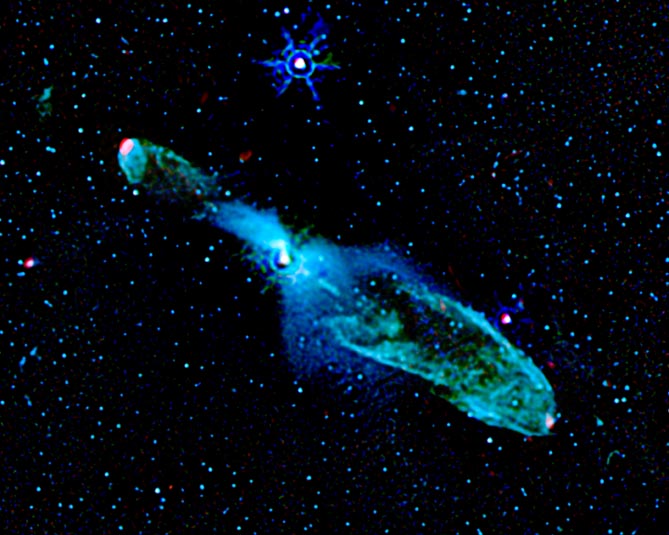
Description: Protostar, Star formation nebula
Position (J2000): RA 8h 25m 41.7s Dec -51° 0' 39.5"
Constellation: Vela
Distance: 1,140 Light Years
Field of View: 4.4 x 3.5 arcminutes
Orientation: North is 0.6° left of vertical
Image Credit: NASA/JPL-Caltech/T. Velusamy (JPL)
Release Date: November 8, 2007
More images: 2003: N0306 2007: N0722 2013: N1336
ABOUT THIS IMAGE:
A new image from NASA's Spitzer Space Telescope shows a baby star 1,140 light-years away from Earth blowing two massive "bubbles." But instead of bubble gum, this youngster, called HH 46/47, is using powerful jets of gas to make bubbles in outer space.
The infant star can be seen as a white spot toward the center of the Spitzer image. The two bubbles are shown as hollow elliptical shells of bluish-green material extending from the star. Wisps of green in the image reveal warm molecular hydrogen gas, while the bluish tints are from starlight scattered by surrounding dust.
These bubbles formed when powerful jets of gas, traveling at 200 to 300 kilometers per second, or about 120 to 190 miles per second, smashed into the cosmic cloud of gas and dust that surrounds HH 46/47. Red specks at the end of each bubble show the presence of hot sulfur and iron gas where the star's narrow jets are currently crashing head-on into the cosmic cloud's gas and dust material.
According to Dr. Thangasamy Velusamy of NASA's Jet Propulsion Laboratory in Pasadena, Calif., baby stars and their potential planet-forming disks grow by gravitationally pulling in and absorbing surrounding gas and dust. Scientists suspect that these disks stop growing when the central baby star develops powerful winds and jets that blow away surrounding material.
"Spitzer can image these jets and winds in infrared light and help us understand the details of these phenomena," says Velusamy.
For astronomers who know what to look for, Spitzer's supersensitive infrared instruments are excellent tools for studying young stars embedded within thick clouds of cosmic dust and gas, revealing information about their growth. However, Velusamy notes that it is often difficult for most people to get a clear, detailed picture of infant stars and their "growing pains."
"When you see a star through a telescope, its image is blurred in a known way, and the smaller the telescope the larger is the blurring," he says.
To clear up this blurring, astronomers at JPL developed an advanced image-processing technique for Spitzer data called Hi-Res deconvolution. This process reduces blurring and makes the image sharper and cleaner, enabling astronomers to see the emissions around forming stars in greater detail. When Velusamy and his team applied this technique to the Spitzer image of HH 46/47, they were able to see winds from the star and jets of gas that are carving the celestial bubbles.
According to Dr. William Langer, also of JPL, this image will help scientists determine which of many different mechanisms are responsible for producing the winds and jets of baby stars.
This infrared image is a three-color composite, with data at 3.6 microns represented in blue, 4.5 and 5.8 microns shown in green, and 24 microns represented as red.